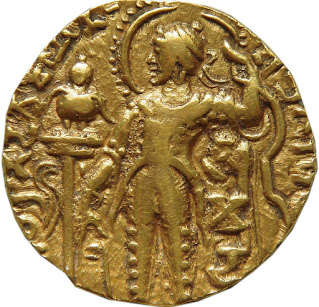Samudragupta: 335-380 AD
Samudragupta was the greatest king of Gupta dynasty. The most detailed and authentic record of his reign is preserved in the Prayaga Prasasti/ Allahabad pillar inscription, composed by his court poet Harisena. In the Gangetic Valley and Centrla India, Samudragupta annexed the territories of the defeated monarchs, but in South India he remained content with victories alone and did not annex the territories of the vanquished rulers. Samudragupta’s military campaigns justify him as the ‘Napoleon of India’ by V.A. Smith. The reference to his dominion over Java, Sumatra and Malaya islands in the sea shows that he had a navy. When he died his mighty empire bordered that of the Kushan of Western province (modern Afghanistan and Pakistan) and Vakatakas in Deccan (modern Southern Maharashtra). His greatest achievement was the political unification of most of India or Aryavarta into a formidable power. Titles: Kaviraja i.e. king of poets (Prayaga Prasasti), Param Bhagavat (Nalanda copper plate), Ashvamedha-parakrama i.e. whose might was demonstrated by the horse-sacrifice (coin), Vikram i.e. prowess (coin), Sarva-raj-ochchetta i.e. uprooter of all kings (coin) etc. Original types of Gold Coins (Dinars): Garud type, Dhanurdhari i.e. Archer type, Axe type, Ashvamedha type, Vyaghrahanan i.e. Tiger-killing type, Veenavadan i.e. lute playing thype. According to the Chinese writer Wang-Hiuen-Tse, Meghavarna, king of Sri Lanka, sent an embassy to Samudragupta for his permission to build a monastery for Buddhist pilgrims at Bodh Gaya.




0 Comments